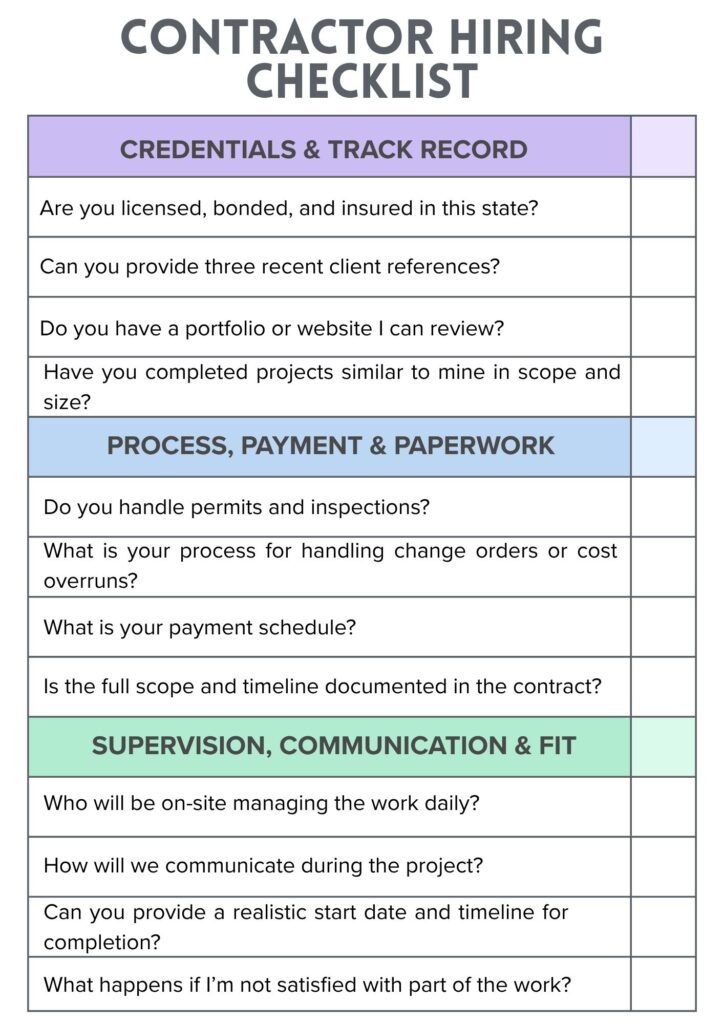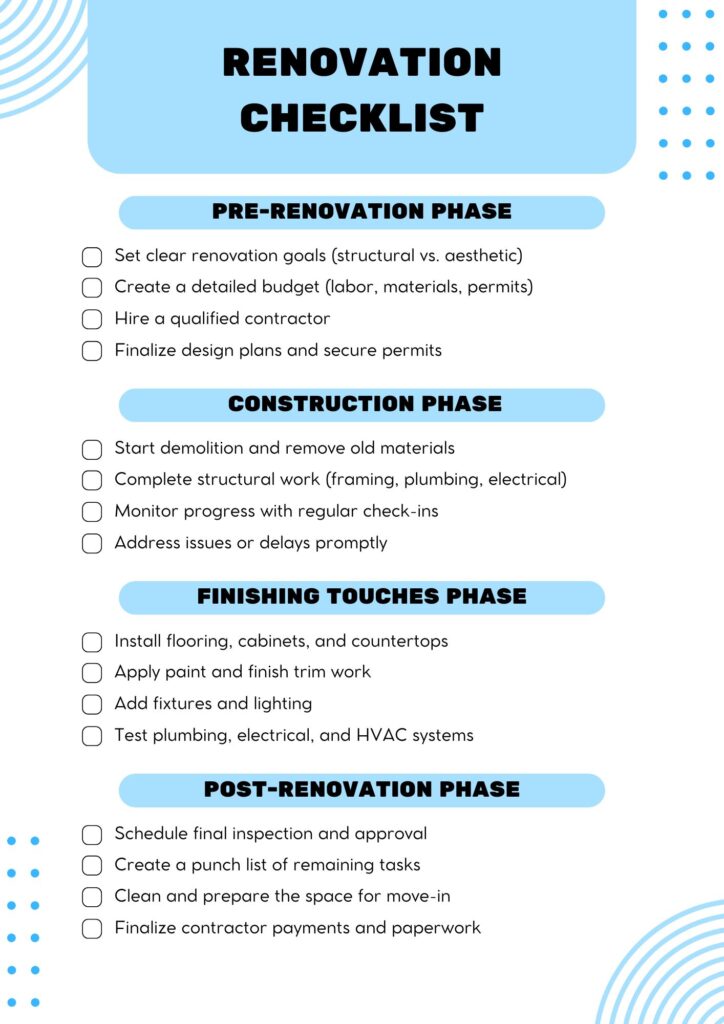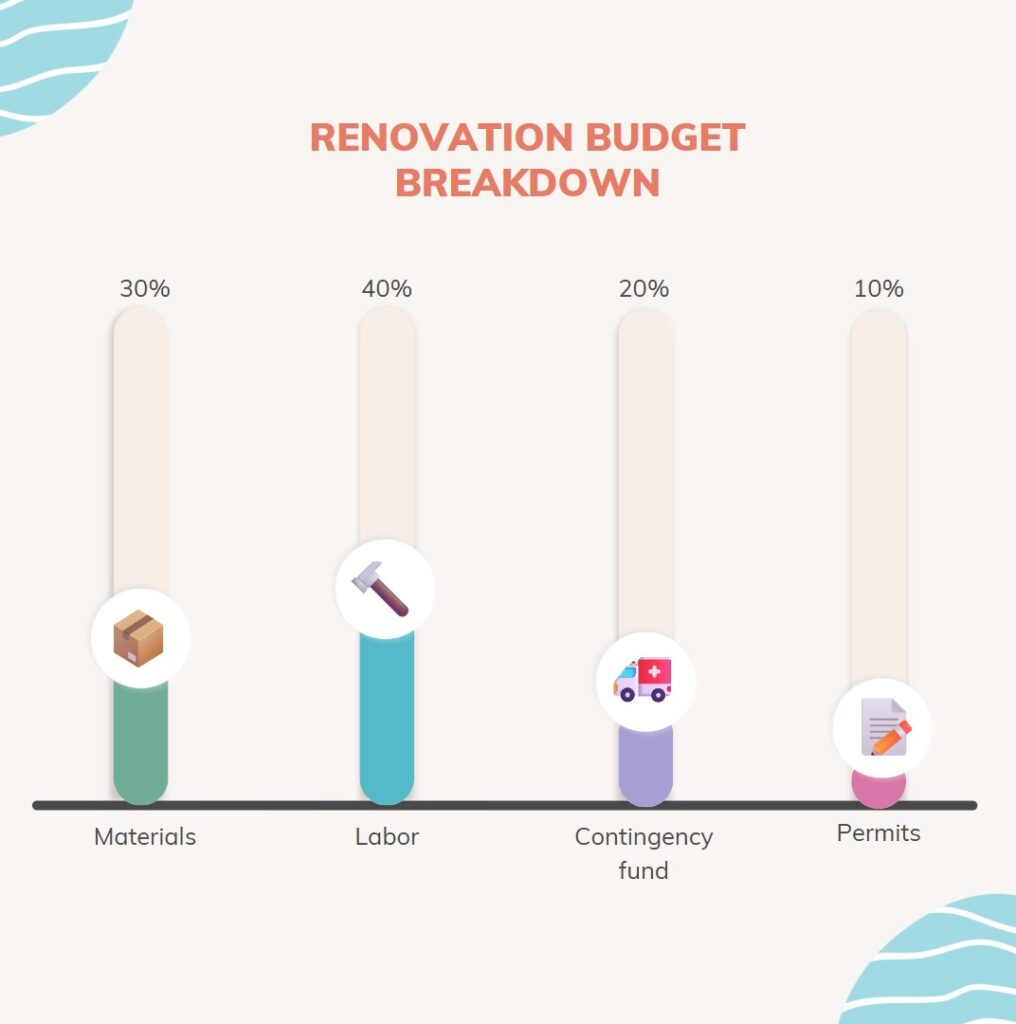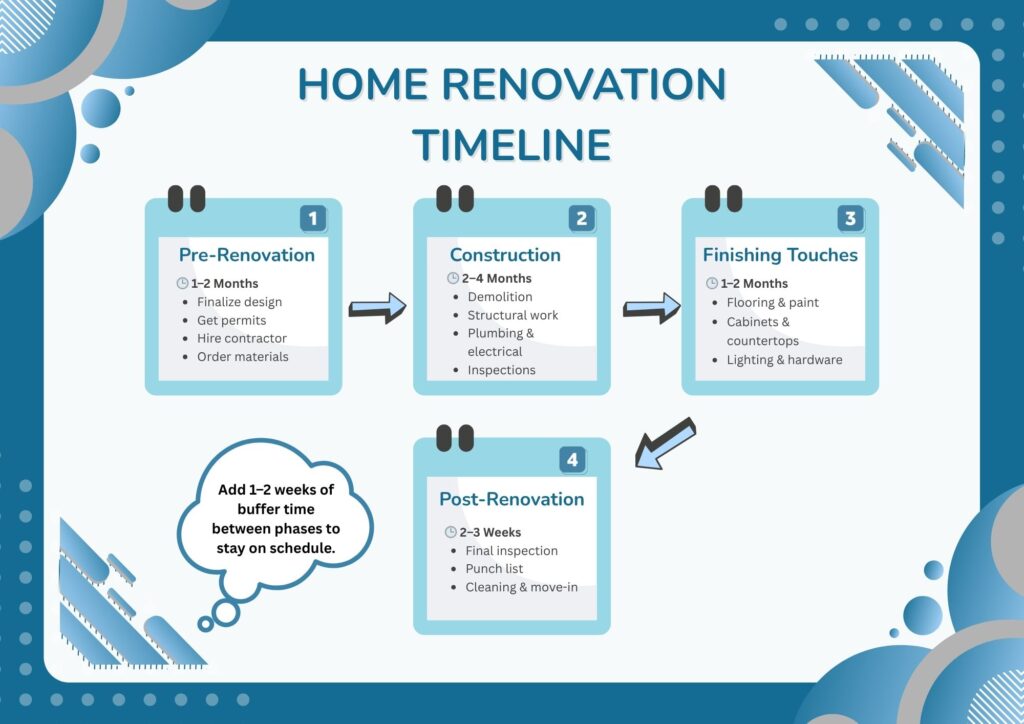A clear and well-structured timeline is essential to the success of any home renovation. A schedule keeps tasks organized, helps control costs, and reduces stress along the way. By prioritizing tasks and setting realistic deadlines, you create a roadmap that keeps the project moving forward. Here is the breakdown of the complete timeline for any home renovation project.
Defining Your Renovation Objectives
It is essential to align your renovation objectives with available resources such as time, budget, and materials. Understanding your limitations ensures that your goals are realistic and manageable.
Begin by distinguishing between necessary updates, like structural improvements, and aesthetic upgrades, such as design changes.
Prioritize the tasks that will have the most significant impact on your home’s functionality and safety.
Organize your goals into clear categories, such as structural improvements and aesthetic upgrades, to make your planning home renovation process more efficient and your timeline more organized.
Crafting a Detailed Renovation Plan
To ensure your renovation stays on track, you would need a highly detailed and hyper specific plan. That will help minimize delays, control costs, and improve communication with contractors. Several critical components need to be planned in advance to fit within your renovation timeline:
Design Considerations
Begin by defining the overall design. The layout, functionality, and style should be determined in the pre-renovation phase (1-2 months before starting). This phase should also include any consultations with architects or designers, if needed. Properly establishing the design early will prevent unnecessary changes later that can disrupt the timeline.
Contractor Selection
Start contractor interviews 2-3 months before the project begins. A solid contractor will help streamline the renovation and prevent delays. Once selected, a clear contract should be drawn up, outlining scope, milestones, and a payment schedule that aligns with the project phases.

Obtaining Necessary Permits
Many home renovations require permits, and obtaining them should be factored into your timeline, typically in the first month. Permits can take time to approve, so start early to avoid delays later on. If multiple inspections are required, they should be planned into your project phases. Failing to obtain the necessary permits or not complying with local regulations can result in fines, delays, or having to redo work.
Legal Advice
Ensure that you understand your local building codes and zoning laws before starting the renovation. In some cases, certain work like structural changes or plumbing may require a licensed contractor or special permits. Always check with your local authorities to confirm which permits are needed and how long they will take to be approved.
Sourcing Materials
Depending on your materials, sourcing them early (at least 1-2 months before construction) ensures that the project won’t be delayed waiting for deliveries. Custom or special-order materials should be handled in advance, allowing time for shipping and delivery before construction begins.
Contract Agreement
The contract should be signed before the construction phase starts (1-2 months in advance). This ensures both you and the contractor have clear expectations of the project timeline, milestones, and payment schedules. This formal agreement prevents miscommunications and delays during the renovation.
Actionable Insight
Create a home renovation plan checklist that includes these elements, and track their progress against the timeline. Make sure to check off items like design finalization, contractor selection, and permit approval as you go, ensuring the renovation stays on schedule.

Estimating Costs and Setting a Realistic Budget
Setting a realistic budget will help you to avoid surprises throughout your home renovation. When estimating the costs, consider every aspect of the project: labor, materials, permits, and potential unforeseen expenses. Here’s a step-by-step approach to help you create a practical budget for your renovation:
Labor Costs
Labor is typically one of the largest expenses in any renovation. Obtain estimates from contractors and workers based on the project scope. Always factor in both direct labor costs (e.g., contractor fees) and any specialized work (e.g., plumbing, electrical).
Material Costs
The cost of materials can vary significantly depending on the quality and type. Make a list of all materials needed, including flooring, paint, cabinetry, and fixtures. Get quotes from suppliers or contractors and allow for any shipping or delivery costs. It is also important to check the estimate of the material carefully as overordering can force you to spend extra money on unnecessary things. For example, if you want to calculate gravel for driveway, french drain, patio or essentially any other purpose, you can use accurate gravel estimation tools for quick check. Keep in mind that prices can fluctuate, so it’s wise to budget slightly higher than expected.
Permits and Fees
Permits can range from a few hundred to several thousand dollars, depending on your location and the nature of the work. It’s crucial to include these costs early in your budget.
Unforeseen Costs
Unexpected issues, such as hidden damage or delays, are common during renovations. To protect yourself from these surprises, allocate a contingency fund—typically 10-20% of your total budget. This fund will provide a cushion for unanticipated expenses that may arise during the renovation.

Structuring a Realistic Home Renovation Timeline
A realistic home renovation timeline is essential for staying on track and ensuring your project runs smoothly. By breaking down the renovation into phases, you can better anticipate how long each stage will take and prepare for potential delays.
Here’s a detailed breakdown of a typical renovation timeline:
Pre-Renovation (1-2 months):
This phase includes the crucial early steps of planning your renovation. In the first month, focus on finalizing your design and securing any necessary permits.
This is also when you’ll be hiring a contractor, selecting materials, and making decisions about the scope of your project.
It’s vital to dedicate time to research, design discussions, and contract negotiations during this phase to ensure everything is in place before construction begins.
Construction Phase (2-4 months):
The construction phase is when the bulk of the work happens. Expect 2 to 4 months of activity, depending on the size and complexity of your project.
This phase typically includes demolition, structural work, plumbing, electrical work, and any foundational improvements.
These tasks can be time-consuming, so it’s important to stick to the timeline, though unexpected issues may arise that could delay work. The more complex the renovation, the longer this phase will take.
Finishing Touches (1-2 months):
Once the main structural work is completed, it’s time for the finishing touches. This phase includes installing cabinetry, flooring, painting, and adding fixtures like light fittings and hardware.
Although this phase often seems quick, it requires attention to detail and proper coordination of subcontractors to avoid delays.
This phase usually takes about one to two months, depending on how many finishing details are involved.
Post-Renovation (2-3 weeks):
The final phase of renovation is the wrap-up period. This includes inspections, final adjustments, and a thorough deep cleaning of the space.
Depending on your location, the post-renovation inspection may be required to ensure the work meets local building codes.
You’ll also need time to touch up minor issues and finalize any paperwork related to permits or contractor agreements.
Always include time buffers in each phase of your timeline. Renovations rarely go exactly as planned, and delays due to contractor scheduling conflicts, material availability, or unexpected structural issues are common.
Adding an extra week or two to each phase will help absorb these delays and keep the project on track.

Strategies to Ensure the Renovation Stays on Track
Regular communication with contractors is essential to ensure your renovation stays on track.
Set clear expectations from the beginning and keep track of the renovation schedule. Frequent updates will help identify issues early, allowing adjustments to be made before they affect the timeline.
Delays can happen, whether due to contractor issues, supply chain disruptions, or unforeseen complications. If delays occur, address them immediately with your contractor. Adjust the timeline as needed and ensure that any changes are clearly documented.
Use project management tools or apps to track progress. Tools like Trello or Asana help you stay organized, monitor milestones, and ensure tasks are completed on time.
Dealing with Unforeseen Challenges During Your Renovation
Unexpected challenges such as hidden structural damage, weather delays, or supply shortages are common in home renovations and can significantly impact the timeline.
For example, discovering issues like water damage or mold during demolition can halt progress, while bad weather can delay work on exterior elements. Supply shortages, especially for custom materials, can also push back construction timelines.
To keep the project on track, address these challenges promptly by consulting with your contractor for solutions. If structural damage is found, prioritize repairs and adjust the schedule accordingly.
For weather delays, focus on indoor work until conditions improve. If materials are delayed, consider alternative options or suppliers to avoid disruption.
The right way to do it is to build flexibility into the timeline to accommodate unforeseen issues.
By adding buffer time between project phases, you allow room for adjustments, ensuring that unexpected challenges don’t derail the overall schedule.
Finalizing Your Renovation and Preparing for Move-In
As your renovation nears completion, it’s time for the final steps: the final renovation inspection, post-renovation cleaning, and a comprehensive walkthrough.
The final inspection ensures that all work complies with local regulations and building codes. It also provides an opportunity to confirm that everything is completed according to plan.
Conduct a detailed walkthrough with your contractor to verify that all aspects of the renovation meet your expectations.
Ensure the project aligns with the agreed-upon scope and timeline. If there are any outstanding issues or unfinished work, address them immediately.
In order to do this, create a final punch list that outlines any remaining tasks or corrections.This list will serve as a checklist to ensure all work is completed before you move in, giving you peace of mind and confirming that the renovation is fully finished.
Common Mistakes in Home Renovation Planning

Here are some common mistakes that you should avoid while renovating your home.
- Neglecting Permits and Legal Requirements: Many homeowners underestimate the importance of securing necessary permits or complying with local building codes. Failing to do so can lead to fines or delays. Always confirm local requirements before starting.
- Underestimating Timeframes: Renovations rarely go as planned. Many underestimate the time each phase will take. Always add extra time for delays, especially during construction and material sourcing.
- Overlooking Budgeting for Unforeseen Costs: Not budgeting for unforeseen issues like structural damage or weather delays can throw your budget off track. Set aside a contingency fund (10-20% of your total budget) to cover these costs.
- Ignoring the Importance of Clear Communication: Failing to set clear expectations with contractors can lead to delays or misunderstandings. Regular communication is essential to keep the project on track.
- Focusing Too Much on Aesthetic Changes: Prioritizing aesthetics over structural or functional updates can cause delays and imbalance. Always address essential issues first.
